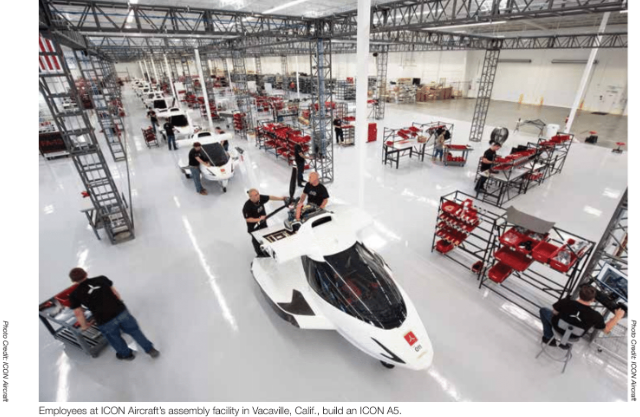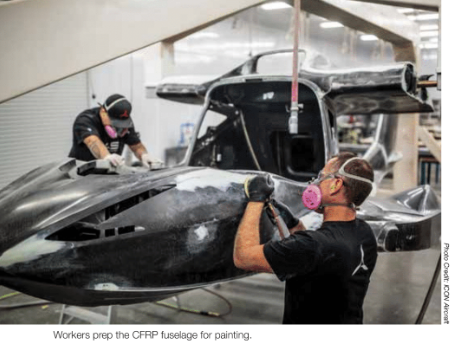
Serial Production Takes Off at ICON Aircraft
When the Federal Aviation Administration (FAA) introduced the light sport aircraft (LSA) category in 2006, pilot and engineer Kirk Hawkins set out to create a simple, versatile LSA that would enable more people to experience the adventure of flying. He founded ICON Aircraft and, together with a team of experts, designed the ICON A5, an amphibious sport plane with folding wings that enable it to be stored in a shed, trailered behind a sport utility vehicle and launched from a shoreline – no airport required. With more than 100 ICON A5s in the market and about 50 more slated for production this year, Hawkins’ vision is coming to fruition, thanks to the characteristics of CFRP and ICON Aircraft’s serial manufacturing capabilities.
With the fuselage, wings, canopy and horizontal tail made completely from CFRP, the 2-seat ICON A5 weighs just 1,510 pounds. While the FAA limit for LSAs is typically 1,300 pounds, the A5 received an additional allowance to include cutting-edge safety features such as a spin-resistant airframe and a full aircraft parachute system. “Using carbon fiber composites was the intent all along because of what these materials offer. They are extremely lightweight but also have an impressive strength-to-weight ratio,” says Verónica Rubio, vice president of supply chain and manufacturing for ICON Aircraft. “The A5 would not have been possible as an LSA without the use of composites.”
The A5 has 375 individual CFRP parts, which are fabricated and bonded into assemblies and sub-assemblies at ICON’s facility in Tijuana, Mexico. Hand lay-up is used to place plies of Toray epoxy prepreg 2 x 2-foot twill fabric onto one of 250 different nickel-iron alloy and aluminum molds. Simple laminates, such as flat surfaces or brackets, have only a few plies, while complex parts, such as the wing spar, require up to 100 plies. Ninety-five of the composite parts utilize an aerospace-grade, closed-cell polymer foam core for rigidity. The lay-up process is laser guided because many of the parts have critical dimensions and require extremely accurate placement.
Following lay-up, the parts are vacuum bagged and cured in an oven (250 F for 100 minutes) or an autoclave (250 F with pressure ranging from 50 to 85 psi and varied cycle times). Once the curing process is complete, the CRFP parts are trimmed and drilled before they are bonded together into 77 assemblies and sub-assemblies. Next, these assemblies are sanded, painted and shipped to ICON’s Vacaville, Calif., facility for final assembly.
As efficient as this process is now, the A5 was not always produced this way. The first 21 pre-production aircraft were individually assembled in California with CFRP components manufactured by four third-party vendors. “I remember back in the day, we had a group of technicians who would basically build the aircraft with a toolbox and a series of drawings,” explains Rubio. In 2016, ICON made the critical move to serialize production, which included bringing composite fabrication in-house to improve part quality and developing its own technical expertise.

ICON spent the next several years building its mass production capability from the ground up: The company constructed a 300,000-square-foot facility in Tijuana, acquired state-of-the-art equipment, recruited and trained technicians, and created administrative and quality control systems to support serial production. “We needed to build a machine to build the machine,” explains Rubio.
The Tijuana plant utilizes lean manufacturing principles. For example, to reduce material movement, production flows along a single aisle with stations for lay-up, curing, bonding and finishing processes adjacent to required supplies and support systems, such as shipping. After each manufacturing process is completed, the company’s ICON Production System (IPS) software activates the previous process to begin again. “We have a facility that is designed for a one-flow, lean pull system,” says Rubio.
Developing the company’s composite manufacturing capability didn’t happen overnight, says Rubio. In-house production of the A5’s composite parts was established over several years. Initially, ICON made simpler, flat panels, then progressed to making more complex parts. In the interim, ICON continued to use third-party suppliers as needed to support aircraft production. This deliberate approach gave the company time to purchase equipment, recruit and train staff, and hone its internal systems.
One key challenge was getting to the ideal production rate. “That’s the key component,” asserts Rubio. “You want to make sure that you get the right quality with the right timing.” This involved adjusting cure cycles, man hours, shift schedules, tooling and more. Ramping up production speed was another challenge. Rubio says that the Tijuana facility gradually reduced wing spar production from three weeks to just 1.5 shifts. Total production time for one A5, including final assembly, is now typically eight to 12 weeks.
Building a skilled workforce was also a key component. The Tijuana facility employs approximately 300 team members. Rubio says that because Tijuana didn’t have a vibrant composites industry, ICON has taken the lead in recruiting and developing skilled workers. The company created its own workforce education program, which begins with basic training in lamination and bonding and continues with functional, on-the-job training as technicians advance through a system of tiered workstations.

The lay-up process, for example, is divided into five work centers, labeled A through E. “If you are a technician in work center A, you work on simpler parts than if you are a tech in work center E,” says Rubio. “It sounds simple, but it requires a robust system to ensure that people are moving from basic to complex jobs with the right qualifications.”
While the company is very proud of its highly-trained workforce, it’s an ongoing endeavor. “It is a day-to-day effort to recruit talent, not only on the composite [production] side, but other functions as well,” says Rubio. “Everything has to do with the company culture – offering the right working conditions and operating under a certain value set. It’s a team effort from leadership and management all the way to the production floor.” In the past few years, ICON Aircraft’s employee attrition rate has declined from the market average of 10% to less than 3%.
Rubio is excited to be a part of ICON’s transition from a research and development company to a serial manufacturer. “It’s been a great journey,” she says. “It has taken a lot of effort and a lot of heart to get to where we are.”

SUBSCRIBE TO CM MAGAZINE
Composites Manufacturing Magazine is the official publication of the American Composites Manufacturers Association. Subscribe to get a free annual subscription to Composites Manufacturing Magazine and receive composites industry insights you can’t get anywhere else.



